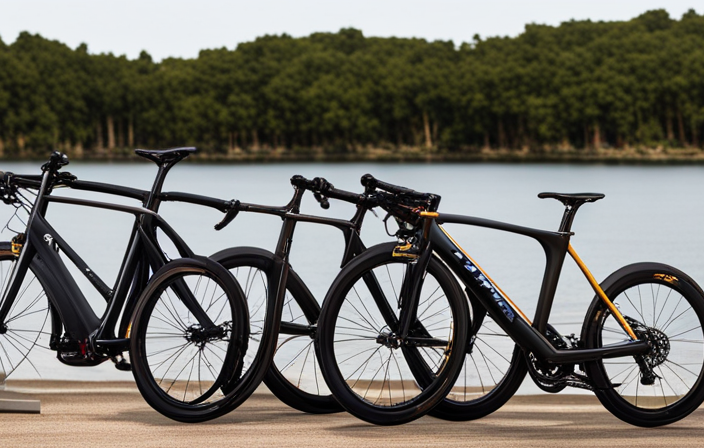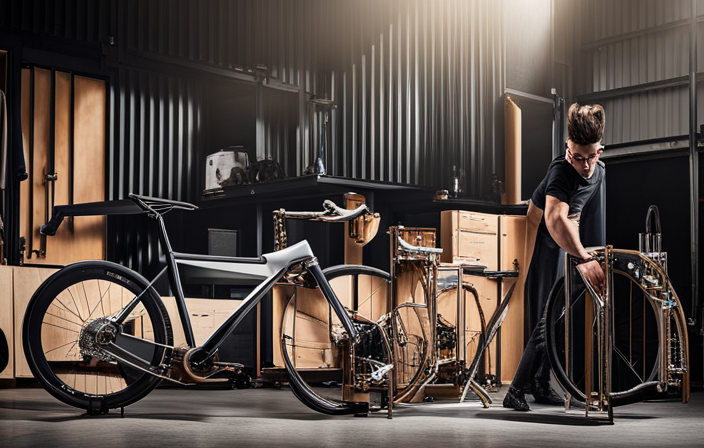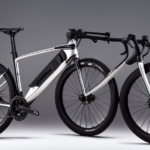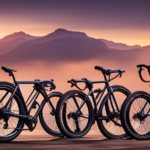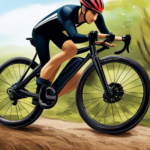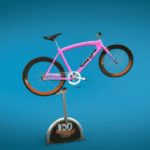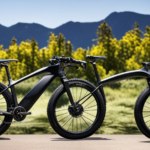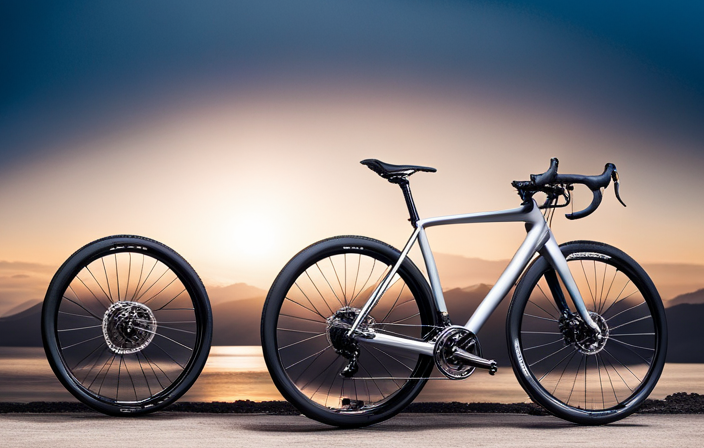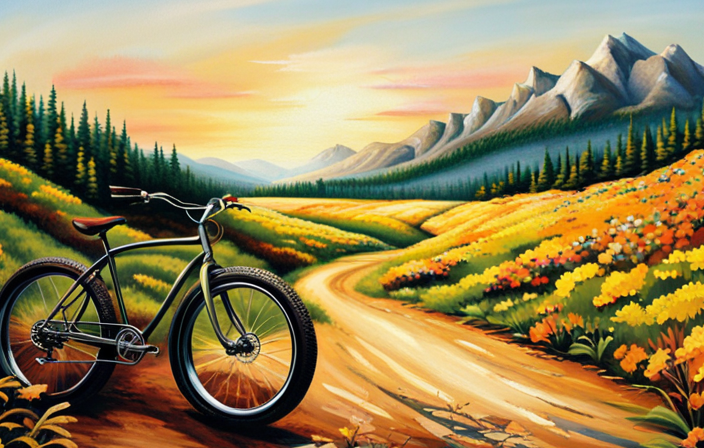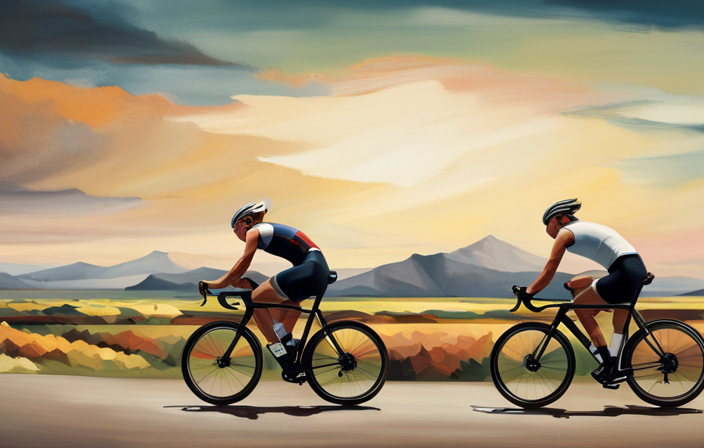Are you a passionate cyclist interested in purchasing a new bike? If that’s the case, let’s delve into the realm of road bikes and compare the key differences between two popular choices: Roubaix bikes and gravel bikes.
While both offer exciting possibilities for adventure on the road less traveled, they differ in frame construction, tire clearance, and overall versatility.
By understanding these nuances, you’ll be better equipped to make an informed decision when it comes to choosing the perfect ride for your cycling needs.
Let’s dive in!
Key Takeaways
- Roubaix bikes are designed for smooth, paved surfaces and offer a comfortable ride, while gravel bikes are designed for off-road adventures and rough terrains.
- Roubaix bikes have a relaxed geometry and use vibration-dampening technologies, while gravel bikes also have a relaxed geometry but prioritize wider tires, disc brakes, and clearance for larger tires.
- Roubaix bikes have a longer top tube and shorter head tube, providing an aerodynamic stance, whereas gravel bikes have a shorter top tube and taller head tube, offering an upright riding position and wider tire clearance.
- Gravel bikes often have suspension and more mounting points for accessories, while Roubaix bikes typically do not have suspension and have fewer mounting points. Groupsets and components also differ, affecting performance and durability.
Overview of Road Bikes
If you’re looking for a versatile road bike, you’ll love the Roubaix and gravel bikes.
Road bikes are designed specifically for riding on smooth, paved surfaces like roads and highways. They are lightweight, fast, and efficient machines that allow riders to cover long distances with ease. As a road cyclist, it’s important to understand road bike maintenance and choose the right road bike for your needs.
Road bike maintenance is crucial to keep your bike running smoothly and safely. This includes regular cleaning, lubrication of the drivetrain components such as the chain and gears, checking tire pressure, and inspecting brake pads for wear. It’s also essential to periodically tune up your road bike by adjusting gears, brakes, and ensuring all components are properly tightened.
Choosing the right road bike depends on various factors such as your riding style, terrain preferences, budget, and future goals. Gravel bikes are a popular choice for riders who enjoy exploring off-road paths or unpaved surfaces. These bikes typically have wider tires with more tread grip to handle different terrains.
Now let’s dive into an introduction to Roubaix bikes where we’ll explore their unique features and advantages in more detail.
Introduction to Roubaix Bikes
Roubaix bikes, also known as endurance road bikes, have a rich history and origins rooted in the cobblestone races of Northern France. These bikes were designed to provide a smooth and comfortable ride over rough terrain, making them ideal for long-distance rides.
Key features of Roubaix bikes include relaxed geometry, vibration-dampening technologies, and wider tires to enhance stability and reduce fatigue. Their design prioritizes comfort without compromising on speed or performance, making them popular among cyclists who enjoy long rides on challenging roads.
Origins and History
When it comes to the origins and history of these bikes, you may be interested to know how they have evolved over time.
The evolution of gravel bikes can be traced back to the early 2000s when cyclists started seeking more versatile options for off-road riding. These bikes were designed to handle a variety of terrains, from smooth pavement to rough gravel roads.
On the other hand, Roubaix bikes have a longer history, dating back to the late 1990s. They were originally created for endurance road racing and are known for their comfort and ability to absorb vibrations.
One key difference between Roubaix and gravel bikes is the materials used in their construction. While Roubaix bikes often feature carbon fiber frames for lightweight performance, gravel bikes tend to use aluminum or steel frames for added durability.
Moving on to key features and design…
Key Features and Design
The key features and design of these bikes are crucial to understanding their performance and versatility. When it comes to bike fit, both the Roubaix bike and the gravel bike prioritize comfort over speed. They feature a more relaxed geometry with a taller head tube, shorter top tube, and longer wheelbase. This allows for a more upright riding position, reducing strain on the back and neck during long rides.
In terms of material selection, both bikes utilize lightweight materials such as carbon fiber or aluminum to ensure a smooth and responsive ride. However, the Roubaix bike often incorporates innovative technologies like Future Shock suspension system that absorbs road vibrations and enhances overall comfort.
These design elements make both bikes well-suited for endurance rides on various terrains, whether it’s tackling rough gravel roads or paved city streets.
As we delve into the introduction to gravel bikes in the next section, we will explore how they further enhance off-road capabilities without compromising on-road performance.
Introduction to Gravel Bikes
When discussing gravel bikes, it is important to understand their purpose and design. These bikes are specifically designed for off-road adventures and rough terrains, making them perfect for exploring gravel roads, dirt trails, and even singletrack paths. They typically feature a more relaxed geometry than road bikes, with wider tires for improved stability and traction.
Key features of gravel bikes include disc brakes for enhanced stopping power in all weather conditions, as well as clearance for larger tires that provide better shock absorption. Additionally, they often have multiple mounting points for racks and fenders, allowing riders to carry gear or accessories on long rides. Components such as a wide-range cassette and lower gearing also make climbing steep hills easier.
In conclusion, gravel bikes are built to handle the demands of off-road riding while providing comfort and versatility. Their purpose-driven design ensures a smooth ride on various surfaces, while key features like disc brakes and mounting points offer practicality and customization options.
Purpose and Design
For your purposes, a Roubaix bike is designed for road racing and offers a more aggressive riding position, while a gravel bike is built to handle rougher terrain and provide a more relaxed riding experience. When choosing between the two, there are several factors to consider:
-
Frame Geometry: A Roubaix bike typically has a longer top tube and shorter head tube, promoting an aerodynamic stance for speed on smooth roads. In contrast, a gravel bike has a more upright position with a shorter top tube and taller head tube for increased stability on uneven surfaces.
-
Tire Clearance: Gravel bikes have wider tire clearance to accommodate larger tires with more tread, allowing for better traction and control on unpaved roads.
-
Suspension: Some gravel bikes come equipped with front suspension or even full suspension systems to absorb shocks from bumps and rough terrain, ensuring a smoother ride.
-
Mounting Points: Gravel bikes often have additional mounting points for racks and other accessories, making them versatile for long-distance touring or bikepacking adventures.
Transitioning into the subsequent section about key features and components of these bikes…
Key Features and Components
Consider the key features and components that make each type of bike unique.
When comparing a Roubaix bike and a gravel bike, there are several key differences to note.
Firstly, the main difference lies in their performance capabilities. A Roubaix bike is designed for road cycling and provides a smooth and efficient ride on paved surfaces. It typically features lightweight materials, aerodynamic design, and narrow tires for maximum speed.
On the other hand, a gravel bike is built for off-road adventures and offers versatility across various terrains. It comes with wider tires for improved traction, more relaxed geometry for comfort during long rides, and added clearance to accommodate mud or dirt buildup. These variations in features result in distinct riding experiences tailored to different environments.
Moving on to the frame and geometry comparison…
Frame and Geometry Comparison
To understand the difference between a Roubaix bike and a gravel bike, you’ll notice that their frame and geometry have distinct characteristics. The Roubaix bike is designed with comfort as its primary focus, while the gravel bike prioritizes performance. This distinction affects both the handling characteristics and stability of these two types of bikes.
Firstly, the Roubaix bike features a more relaxed geometry compared to the gravel bike. It has a taller head tube and shorter top tube, which results in a more upright riding position. This allows for greater comfort over long distances, as it reduces strain on the rider’s back and neck.
On the other hand, the gravel bike has a more aggressive geometry that enhances its performance capabilities. With a lower stack height and longer reach, it offers a more aerodynamic riding position suitable for faster speeds and nimble maneuvering.
In summary:
- The Roubaix bike prioritizes comfort over performance.
- The gravel bike emphasizes performance over comfort.
- The Roubaix has a more relaxed geometry for an upright riding position.
- The gravel bike has an aggressive geometry for speed and agility.
- These differences in frame and geometry contribute to variations in handling characteristics and stability between the two.
Moving on to tire clearance and width…
Tire Clearance and Width
When it comes to tire clearance and width, there are significant differences between a Roubaix bike and a gravel bike.
The Roubaix bike typically has narrower tire clearance, usually accommodating up to 32mm tires, while a gravel bike offers much wider clearance, allowing for larger tires ranging from 38mm to even 50mm or more.
This difference in tire sizes and options directly impacts the ride quality of the two bikes.
With narrower tires on the Roubaix, it excels on smooth roads and provides a faster and more efficient ride.
On the other hand, the wider tires on a gravel bike provide better traction, stability, and comfort on rougher terrain such as gravel roads or trails.
Differences in Tire Sizes and Options
The main distinction between a Roubaix bike and a gravel bike lies in their tire sizes and options.
Gravel bikes are typically equipped with wider tires compared to Roubaix bikes, allowing for more stability and traction on rough terrain. The wider tires also allow for lower tire pressure, which helps absorb bumps and provide a smoother ride. This is especially beneficial when tackling gravel roads or uneven surfaces where maintaining control and stability is crucial.
On the other hand, Roubaix bikes have narrower tires that offer less rolling resistance on smooth pavement, making them ideal for road cycling at higher speeds. However, the trade-off is reduced comfort and handling on rougher surfaces.
The difference in tire sizes and options greatly impacts the ride quality and terrain suitability of these two types of bikes.
Moving on to the impact on ride quality and terrain suitability…
Impact on Ride Quality and Terrain Suitability
The tire sizes and options of Roubaix bikes and gravel bikes have a significant impact on their ride quality and suitability for different terrains.
When it comes to ride comfort, the wider tires found on gravel bikes provide better cushioning and shock absorption compared to the narrower tires typically seen on Roubaix bikes. This allows for a smoother ride over rough surfaces and uneven terrain.
Gravel bikes also tend to have more aggressive tread patterns, which enhance their off-road capability by providing better traction in loose or muddy conditions. On the other hand, Roubaix bikes prioritize speed on smooth pavement, with narrower tires offering lower rolling resistance. Their focus is more on efficiency rather than off-road performance.
Transitioning into the next section about suspension and damping, let’s now explore how these features further enhance the overall riding experience.
Suspension and Damping
You’ll notice the difference in suspension and damping between a Roubaix bike and a gravel bike. The suspension system on a Roubaix is designed to absorb vibrations and bumps on the road, providing a smoother ride and minimizing impact on comfort. It usually features some form of front and rear suspension, such as Zertz inserts or Future Shock technology, that helps dampen road vibrations. This design not only improves comfort but also has an impact on handling by keeping the tires better planted on rough surfaces.
In contrast, gravel bikes typically have less suspension or none at all. They rely more on wider tires with lower pressure to absorb shocks and vibrations. While this setup may not provide the same level of comfort as a Roubaix, it offers greater versatility when riding off-road terrains. The lack of suspension can make gravel bikes more responsive and agile, allowing for quicker maneuvering through loose gravel or uneven terrain.
- The suspension system on a Roubaix enhances comfort by dampening road vibrations.
- It improves handling by keeping the tires better planted on rough surfaces.
- Gravel bikes often have little to no suspension but rely on wider tires for shock absorption.
Transitioning into the subsequent section about ‘riding position and comfort,’ it’s important to consider how these factors contribute to overall bike performance.
Riding Position and Comfort
When it comes to riding position and comfort, Roubaix bikes are known for their endurance-focused geometry. This means that the bike is designed to keep the rider in a comfortable and efficient position for long hours in the saddle.
On the other hand, gravel bikes offer a versatile and relaxed riding position, allowing riders to tackle various terrains with ease. The more upright positioning of a gravel bike provides a comfortable experience while still maintaining control and stability on rough surfaces.
Roubaix Bikes’ Endurance-Focused Geometry
Although it’s similar to a gravel bike, a Roubaix bike has an endurance-focused geometry. This means that the design of the bike is optimized for long rides and comfort rather than pure speed and performance.
The geometry of a Roubaix bike typically features a taller head tube, which allows for a more upright riding position. This helps to reduce strain on the neck and back, making it more comfortable for longer periods in the saddle.
Additionally, the Roubaix bike often has a longer wheelbase and slacker head angle compared to a gravel bike. These characteristics contribute to increased stability and control over rough terrain.
With its emphasis on endurance and comfort, the Roubaix bike provides an ideal option for riders who prioritize long-distance rides and smoothness over outright speed.
Transitioning into the subsequent section about gravel bikes, their versatile and relaxed riding position offers a different experience altogether.
Gravel Bikes’ Versatile and Relaxed Riding Position
The versatile and relaxed riding position of a gravel bike provides a unique riding experience. Unlike other bikes, the gravel bike is designed to handle various terrains, from smooth pavement to rough dirt roads. This adaptability makes it perfect for long rides or off-road adventures.
Comfort: The more upright riding position reduces strain on the neck and back, allowing for longer hours in the saddle without discomfort.
Stability: The wider tires and lower bottom bracket height offer better stability, especially when navigating through uneven surfaces or loose gravel.
Control: The relaxed geometry of the frame ensures precise handling and control over the bike, making it easier to maneuver in tight spaces.
With its comfortable and stable riding position benefits, a gravel bike allows riders to enjoy their journeys with confidence.
Now let’s explore how gear ratio and drivetrain contribute to an exceptional gravel biking experience.
Gear Ratio and Drivetrain
When it comes to discussing gear ratio and drivetrain, there are two key points that I find particularly interesting.
The first is the importance of gear range and options for different riding conditions. Having a wide range of gears allows for efficient pedaling on steep climbs and quick acceleration on flat roads.
The second point worth exploring is the differences in groupsets and components, which can greatly affect the overall performance and durability of a bike’s drivetrain system.
Understanding these factors can help riders make informed decisions when selecting a bike or upgrading their current setup.
Gear Range and Options for Different Riding Conditions
For different riding conditions, you’ll want to consider the gear range and options available on both a Roubaix bike and a gravel bike. The gear range comparison is essential as it determines the variety of gears you can utilize to tackle various terrains. Let’s take a look at the table below to understand the differences:
| Riding Condition | Roubaix Bike Gear Range | Gravel Bike Gear Range |
|---|---|---|
| Climbing Mountains | Wide range of low gears | Wide range of low gears |
| Flat or Rolling Roads | Narrower range of gears | Wider range of gears |
| Off-road Trails | Limited gear options | Wide range of gears |
Proper gear selection is crucial for an optimal riding experience. When climbing mountains, both bikes offer a wide range of low gears to conquer steep inclines. However, on flat or rolling roads, gravel bikes provide a wider array of gear options compared to Roubaix bikes. Additionally, when venturing off-road onto challenging trails, gravel bikes excel with their wide gear selection.
Now let’s delve into the next section about the differences in groupsets and components without skipping a beat.
Differences in Groupsets and Components
To better understand the groupsets and components, let’s explore the various options available for you.
When it comes to groupset options, both Roubaix bikes and gravel bikes offer a range of choices to suit your riding style and preferences. Here are three key factors to consider:
-
Number of gears: Gravel bikes often come with a wider range of gears, allowing for easier climbing on rough terrain. On the other hand, Roubaix bikes tend to have fewer gears but offer smoother shifting for a more efficient road cycling experience.
-
Component compatibility: Both types of bikes can be equipped with high-quality components from reputable brands like Shimano or SRAM. However, it’s important to ensure that the components you choose are compatible with your bike’s frame and drivetrain system.
-
Price range: The cost of groupsets can vary significantly depending on the level of performance and quality you desire. Higher-end groupsets typically offer lighter weight, improved durability, and enhanced functionality but come at a higher price point.
Now that we’ve covered the differences in groupsets and components, let’s move on to discussing brake systems without skipping a beat.
Brake Systems
The main difference between a Roubaix bike and a gravel bike is their brake systems. When it comes to comparing these two types of bikes, the brake performance evaluation is crucial.
The Roubaix bike typically features rim brakes or disc brakes, depending on the model. Rim brakes work by applying pressure to the sides of the wheel rims, providing reliable stopping power. On the other hand, disc brakes offer better modulation and braking performance in all weather conditions.
Gravel bikes, on the other hand, commonly come equipped with disc brakes. These brakes provide superior stopping power and control on rough terrains encountered during off-road adventures. Disc brakes allow for precise braking modulation and are less affected by mud, water, or debris that can accumulate on your wheels.
Transitioning into the subsequent section about wheelset and accessories: Speaking of wheelsets and accessories…
Wheelset and Accessories
Transitioning into the subsequent section about wheelset and accessories, let’s take a look at the features of their respective wheelsets.
-
Wheelset Comparison:
-
Roubaix Bike: The Roubaix bike typically comes with lightweight carbon fiber wheels. These wheels are designed to provide a smooth and efficient ride on paved roads. They are optimized for speed and performance, allowing riders to tackle long distances with ease.
-
Gravel Bike: On the other hand, gravel bikes usually feature more robust wheelsets. These wheelsets are built to withstand rougher terrains and handle off-road adventures. They often have wider rims that accommodate larger tires, providing better traction and stability on uneven surfaces.
-
Accessories for Gravel Biking:
-
Gravel-specific Tires: To enhance grip and control on loose gravel or dirt trails, many gravel bikers opt for wider tires with aggressive tread patterns.
-
Frame Bag: A frame bag is a popular accessory among gravel bikers as it offers additional storage space for tools, snacks, or other essentials during long rides in remote areas.
When considering which bike is right for you, it’s important to evaluate your intended riding style and preferred terrain. Now let’s delve into terrain and riding style considerations in the next section.
Terrain and Riding Style Considerations
When choosing the right bike for you, it’s important to consider your preferred terrain and riding style. Both the Roubaix bike and the gravel bike offer versatility in terms of where they can be ridden, but there are some key differences to keep in mind.
If you’re mainly planning to ride on smooth roads or paved surfaces, a Roubaix bike might be more suitable for you. These bikes are designed with endurance in mind and excel on long rides with minimal bumps. The frame geometry is optimized for a more relaxed riding position, which can be beneficial if you prefer a comfortable and stable ride.
On the other hand, if you enjoy exploring off-road trails or tackling rougher terrains, a gravel bike would be a better choice. Gravel bikes have wider tires and increased clearance, allowing them to handle uneven surfaces with ease. The frame geometry is typically more aggressive than that of a Roubaix bike, providing better control and maneuverability on unpredictable terrain.
Considering your terrain considerations and riding style preferences will help you determine which type of bike suits you best. In the next section, we will delve into the pros and cons of Roubaix bikes without losing sight of their capabilities on different types of terrains.
Pros and Cons of Roubaix Bikes
When it comes to endurance road riding, Roubaix bikes offer significant advantages. They are designed to minimize fatigue during long-distance rides with their comfortable and smooth ride quality. The advanced technology used in their construction, such as specialized frame geometry and innovative suspension systems, ensures a high level of comfort and stability on rough roads.
However, it is important to note that Roubaix bikes have limitations when it comes to off-road and gravel riding. This is due to their narrower tires and less aggressive handling characteristics.
Advantages for Endurance Road Riding
One advantage for endurance road riding is that a Roubaix bike provides a smooth and comfortable ride. This is due to its endurance-focused geometry, which prioritizes rider comfort and stability over aggressive racing positions. The frame of the Roubaix bike absorbs vibrations and shocks from rough roads, ensuring a more pleasant experience during long rides. Additionally, the carbon fiber construction of the frame helps to reduce weight without compromising strength.
To visualize this, consider the following table:
| Advantages for Endurance Road Riding |
|---|
| Smooth and comfortable ride |
| Absorbs vibrations |
| Stable on rough roads |
| Lightweight yet strong |
These features make the Roubaix bike an excellent choice for riders looking to tackle long distances with ease. However, it’s important to note that these advantages are specific to road riding, as the limitations of a Roubaix bike become apparent when venturing off-road or onto gravel paths.
Limitations for Off-Road and Gravel Riding
The Roubaix bike has its limitations when it comes to off-road and gravel riding. While it excels in endurance road riding, the bike’s design and features are not optimized for the demands of off-road terrain.
The main limitation lies in its tire clearance, which is typically narrower compared to a dedicated gravel bike. This means that the Roubaix may struggle with loose surfaces, mud, or rough trails where wider tires provide better traction and stability.
Additionally, the frame geometry of the Roubaix is more focused on comfort and efficiency on paved roads rather than agility and control on unpredictable off-road surfaces.
Therefore, if you’re looking to tackle challenging off-road trails or gravel adventures, a dedicated gravel bike would be a better choice. However, it’s worth noting that there are pros and cons to consider when choosing a gravel bike as well.
Pros and Cons of Gravel Bikes
You’ll find that gravel bikes offer the versatility to handle a variety of terrains, but they may not be as efficient on paved roads compared to other types of bikes. This is because gravel bikes are designed with specific features that prioritize off-road performance over speed on smooth surfaces. Here are three key aspects of gravel bikes that contribute to their versatility and stability:
-
Tire Clearance: Gravel bikes typically have wider tire clearance, allowing you to use larger tires with more aggressive tread patterns. This provides better traction and control on loose or uneven surfaces.
-
Frame Geometry: Gravel bike geometry strikes a balance between road and mountain bike designs. They often have a longer wheelbase and slacker head tube angle for added stability, especially when riding over rough terrain.
-
Mounting Points: Gravel bikes come equipped with multiple mounting points for accessories like racks, fenders, and water bottle cages. This allows you to carry extra gear for long-distance adventures or bikepacking trips.
Considering these factors, gravel bikes are an excellent choice if you enjoy exploring unpaved trails or embarking on multi-terrain adventures. However, if your primary focus is fast-paced road riding or racing, you might want to consider other options that prioritize efficiency on smooth pavement.
Now let’s delve into choosing the right bike for you based on your specific needs and preferences.
Choosing the Right Bike for You
When choosing the right bike for you, consider your specific needs and preferences. It’s important to find a bike that fits you well and suits the type of riding you plan to do. To help with this decision, I’ve created a table comparing the key factors between Roubaix bikes and gravel bikes:
| Roubaix Bike | Gravel Bike | |
|---|---|---|
| Riding | Ideal for smooth roads | Designed for off-road adventures |
| Frame | Lightweight carbon fiber | Sturdy aluminum or steel |
| Tires | Thin, smooth road tires | Wide, knobby tires for traction |
| Geometry | More aggressive and aerodynamic | Relaxed and stable |
To ensure a proper fit on your chosen bike, it’s recommended to get a professional bike fitting. This will help adjust the saddle height, handlebar position, and other factors to optimize comfort and performance. Additionally, regular maintenance is crucial to keep your bike in top condition. Some maintenance tips include cleaning your drivetrain regularly, checking tire pressure before each ride, lubricating moving parts, and inspecting brakes for wear.
In conclusion and final recommendations… [transition sentence].
Conclusion and Final Recommendations
Overall, it’s important to carefully consider your specific needs and preferences when choosing the right bike for you. When it comes to selecting a bike, two popular options are the Roubaix bike and the gravel bike.
While both bikes are designed for comfort and versatility, there are some key differences to keep in mind.
Firstly, one important consideration is bike fit and sizing. A properly fitting bike is crucial for comfort and performance. The Roubaix bike typically has a more relaxed geometry, offering a more upright riding position that suits riders looking for long-distance comfort. On the other hand, gravel bikes often have a more aggressive geometry with a lower front end for better handling on rough terrain.
Secondly, different rider preferences and goals should be taken into account. If you mainly ride on smooth roads or participate in endurance events like Gran Fondos, the Roubaix bike may be your best bet. It features advanced suspension technology that helps dampen vibrations from rough surfaces. Meanwhile, if you enjoy exploring off-road trails or gravel paths, a gravel bike would suit you better due to its wider tire clearance and stable frame design.
In conclusion, choosing between a Roubaix bike and a gravel bike ultimately depends on your specific needs and preferences as a rider. Consider factors such as bike fit and sizing as well as your intended riding style before making your final decision. Happy riding!
Frequently Asked Questions
What is the difference in weight between a Roubaix bike and a gravel bike?
The difference in weight between a Roubaix bike and a gravel bike can be attributed to several factors.
Firstly, the difference in frame material plays a significant role. Roubaix bikes typically have carbon frames, which are lighter than the aluminum frames commonly used on gravel bikes.
Additionally, the tire width also affects the weight. Gravel bikes have wider tires for off-road adventures, while Roubaix bikes usually have narrower tires for smoother road riding.
Can a gravel bike be used for road biking as well?
A gravel bike can definitely be used for road biking, including commuting. It offers several benefits for road riding.
The wider tires provide greater stability and comfort on rough roads or potholes.
The relaxed geometry of a gravel bike allows for a more upright and comfortable riding position, reducing strain on the back and neck during long rides.
Additionally, the versatility of a gravel bike makes it suitable for both off-road adventures and smooth pavement cycling.
Are Roubaix bikes more expensive than gravel bikes?
Roubaix bikes are generally more expensive than gravel bikes due to their advanced features and construction.
While both types of bikes can handle rough terrain, roubaix bikes are designed for endurance road cycling and prioritize comfort over off-road capabilities.
They feature high-end components, such as carbon frames and disc brakes, which contribute to their higher price point.
Additionally, roubaix bikes are known for their exceptional durability, making them a long-lasting investment for serious cyclists.
Can suspension be added to a gravel bike?
Adding suspension to a gravel bike can certainly enhance its performance, but whether it’s worth it depends on your riding style and preferences. Suspension helps absorb shocks and vibrations, providing a smoother ride on rough terrain.
However, it adds weight and complexity to the bike, which may reduce efficiency on smoother surfaces. It’s important to consider the type of trails you ride and how much comfort you prioritize before deciding if adding suspension is right for you.
Are Roubaix bikes suitable for off-road riding?
Roubaix bikes, designed for endurance road cycling, are not ideal for off-road riding due to their limited off-road capabilities. They prioritize comfort and efficiency on smooth surfaces.
In contrast, gravel bikes excel in tackling rough terrains like mountain trails. With wider tires and more versatile geometry, they offer better stability and control on uneven surfaces. Gravel bikes are specifically built to handle the challenges of off-road riding, making them a suitable choice for mountain trails.
Conclusion
After carefully comparing the features and characteristics of Roubaix bikes and gravel bikes, it is clear that they are designed for different types of riding.
While Roubaix bikes excel in providing a smooth and comfortable experience on paved roads, gravel bikes are built to handle rough terrains with their wider tire clearance and sturdier frames.
Both options have their pros and cons, so it ultimately comes down to personal preference and the type of terrain you plan on riding.
To make an informed decision, consider your riding style and preferences before choosing between these two exceptional bike options.
